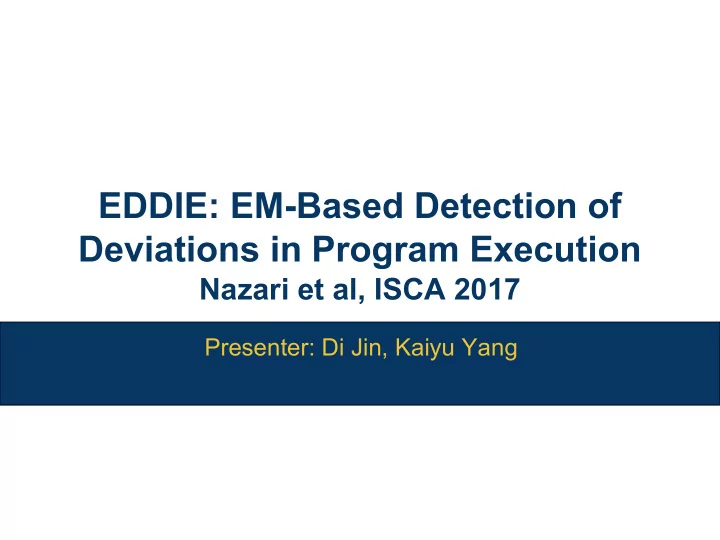

EDDIE: EM-Based Detection of Deviations in Program Execution Nazari et al, ISCA 2017 Presenter: Di Jin, Kaiyu Yang
Motivation ● Security matters ○ Hackers want your private information ○ In loT (Internet of Things) , attacks have further influence. ○ Advanced attacks can bypass static malware detection (e.g., anti-viruses, memory scan) through code mutation / injection . ○ A fast, accurate detector monitoring the software execution is in urgent need. Source: https://www.shutterstock.com/search/malware
Traditional malware detection ● Signature-based ○ Detect attack if the signatures have been observed. ■ New attack signatures ■ Could be bypassed by metamorphic malware ● Anomaly-based ○ Monitor a set of features , report any deviations from the reference model as attacks. ○ Software monitoring ■ High performance overhead, low accuracy. ○ Hardware monitoring ■ High power consumption
Goal ● EM emanations ○ Widely used in attacks ■ Side-channel attack (e.g., Van Eck phreaking) ■ Program profiling through EM signals ● Can we use EM for security? ● EDDIE ( E M-based D etection of D eviations i n Program E xecution) ○ An EM emanation-based approach to monitoring program execution and detecting anomalies. ○ No direct intrusion to monitored systems, minimized overhead. ○ In the context of code injection, both burst and slow injections should be detected w. high accuracy and low latency. Source: https://www.shutterstock.com/search/computer+cartoon
EDDIE : Overview ● Idea: use the observed EM spectra of each part of the program over time as reference to find deviations.
Implement. ● STFT (Short-Term Fourier Transformation) ○ Input: time-domain signals ○ Output: a sequence of windows: time-frequency distribution ● STS (Short-Term Spectrum) STFG: an example ○ Convert signals in windows into spectrum. ● Reference: a sequence of STSs in training ○ Model loop regions and inter-loop region. ■ Peaks: active loops ○ If: Then: mark as anomaly. Peaks in STS: active loop activity in program execution Source: Wikipedia, Nazari et al.
Implement. ● Training phase ○ Goal: ■ Find the possible STS sequences in which loop and inter-loop regions may execute. ■ Collect & map sample windows to those regions. ○ Loop-level state machine ■ “Peaks” in spectrum. ■ Profile program execution. ○ Measurement: ■ Signal sequence ■ Region identifier ■ Loop entry time ■ Exit time
EDDIE: Implementation ● Statistical test ○ STSs (sequence of Short-Term Spectra) belonging to the same code region are unlikely the same. ○ K-S test: nonparametric test to compare the observed and reference STS distributions. ○ One test for a peak: 1st strongest, 2nd strongest, … Parametric test is not suitable in this case. Source: Nazari et al.
EDDIE: Implementation ● Trade-off between detection accuracy and latency ○ The number of monitoring-observed STSs for K-S test ( n ) ■ Small n : low latency (recently STSs), low accuracy ■ Large n : high latency, high accuracy ○ In training, EDDIE determines n separately for each region. ■ Perform a “grid search” on n for the minimum false rejection rate (training phase is injection-free) Source: Nazari et al.
Experiments on a Real IoT Device ● Setup ○ ARM Cortex A8 processor ○ EM received by an antenna right above the processor and displayed by an oscilloscope. ○ 10 benchmarks from the MiBench suite, each executed 25 times during training ● Injection ○ Outside loops: invoking a shell and return (476k instructions, 3ms execution time) ○ Inside loops: 4 integer operations and 4 memory accesses (8 instructions) Source: Nazari et al.
Effects of Various Factors ● Processor architectures ○ Power consumption signal generated by a simulator ○ 51 configurations, in-order or out-of-order, issue widths, pipeline depths, ROB sizes ○ Out-of-order cores have significantly higher latency ○ Pipeline depth has a weak effect, which diminishes when increasing the injection size ● Injection execution rate ○ Inject code inside loops ○ Contamination rate: the percentage of iterations that contain injected code Source: Nazari et al.
Effects of Various Factors ● Size of injection ○ Inject inside loops: even two-instruction injections can be detected with high accuracy ○ Inject outside loops ● Instructions type ○ 8 ADD v.s. 4 ADD & 4 STORE ○ Off-chip operations are easier to detect Source: Nazari et al.
Conclusions ● The paper proposes EDDIE, an EM-based method for detecting anomalies in program execution. ● It has the advantage of introducing no overheads or any hardware/software change in the monitored system. ● EDDIE characterizes normal execution behavior in terms of peaks in the EM spectrum and identifies abnormal peaks during testing. ● EDDIE is evaluated both on a real IoT system and in a simulator. It is shown to be effectively for different processor architectures and code injection patterns.
Discussion ● Is EDDIE applicable in real-world (industry, academia)? ● What if the environment is power-costly, EM-noisy? ● Why does EDDIE try to avoid direct intrusion on the monitored system? ● Can EM-based anomaly detection be improved through ensembling? Features in existing works: acoustics emanations, power, timing variations, etc. ● Can we use models such as SVM to directly classify the EM signal to be normal/abnormal?
Q&A ● Thanks
Recommend
More recommend